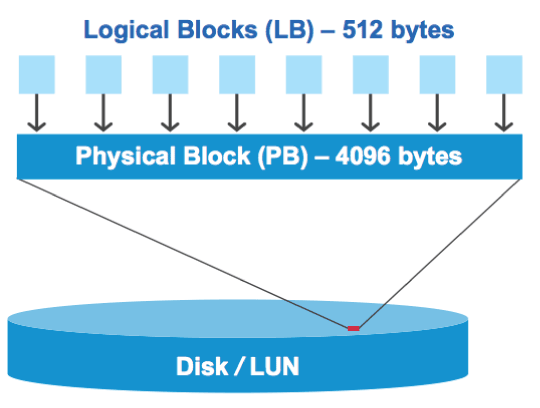I/O misalignments on properly aligned LUNs overview
 Suggest changes
Suggest changes


ONTAP might report I/O misalignments on properly aligned LUNs. In general, these misalignment warnings can be disregarded as long as you are confident that your LUN is properly provisioned and your partitioning table is correct.
LUNs and hard disks both provide storage as blocks. Because the block size for disks on the host is 512 bytes, LUNs present blocks of that size to the host while actually using larger, 4-KB blocks to store data. The 512-byte data block used by the host is referred to as a logical block. The 4-KB data block used by the LUN to store data is referred to as a physical block. This means that there are eight 512-byte logical blocks in each 4-KB physical block.

The host operating system can begin a read or write I/O operation at any logical block. I/O operations are only considered aligned when they begin at the first logical block in the physical block. If an I/O operation begins at a logical block that is not also the start of a physical block, the I/O is considered misaligned. ONTAP automatically detects the misalignment and reports it on the LUN. However, the presence of misaligned I/O does not necessarily mean that the LUN is also misaligned. It is possible for misaligned I/O to be reported on properly aligned LUNs.
If you require further investigation, see the NetApp Knowledge Base: How to identify unaligned IO on LUNs?
For more information about tools for correcting alignment problems, see the following documentation:
Achieve I/O alignment using LUN OS types
For ONTAP 9.7 or earlier, you should use the recommended ONTAP LUN ostype value that most closely matches your operating system to achieve I/O alignment with your OS partitioning scheme.
The partition scheme employed by the host operating system is a major contributing factor to I/O misalignments. Some ONTAP LUN ostype values use a special offset known as a “prefix” to enable the default partitioning scheme used by the host operating system to be aligned.

|
In some circumstances, a custom partitioning table might be required to achieve I/O alignment. However, for ostype values with a “prefix” value greater than 0, a custom partition might create misaligned I/O.
|
For more information on LUNs provisioned in ONTAP 9.7 or earlier, see the NetApp Knowledge Base: How to identify unaligned IO on LUNs.

|
By default, new LUNs that are provisioned in ONTAP 9.8 or later have a prefix and suffix size of zero for all LUN OS types. The I/O should be aligned with the supported host OS by default. |
Special I/O alignment considerations for Linux
Linux distributions offer a wide variety of ways to use a LUN including as raw devices for databases, various volume managers, and file systems. It is not necessary to create partitions on a LUN when used as a raw device or as physical volume in a logical volume.
For RHEL 5 and earlier and SLES 10 and earlier, if the LUN will be used without a volume manager, you should partition the LUN to have one partition that begins at an aligned offset, which is a sector that is an even multiple of eight logical blocks.
Special I/O alignment considerations for Solaris LUNs
You need to consider various factors when determining whether you should use the solaris ostype or the solaris_efi ostype.
See the Solaris Host Utilities Installation and Administration Guide for detailed information.
ESX boot LUNs report as misaligned
LUNs used as ESX boot LUNs are typically reported by ONTAP as misaligned. ESX creates multiple partitions on the boot LUN, making it very difficult to align. Misaligned ESX boot LUNs are not typically a performance problem because the total amount of misaligned I/O is small. Assuming that the LUN was correctly provisioned with the VMware ostype, no action is needed.


